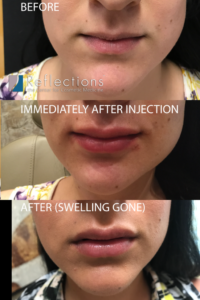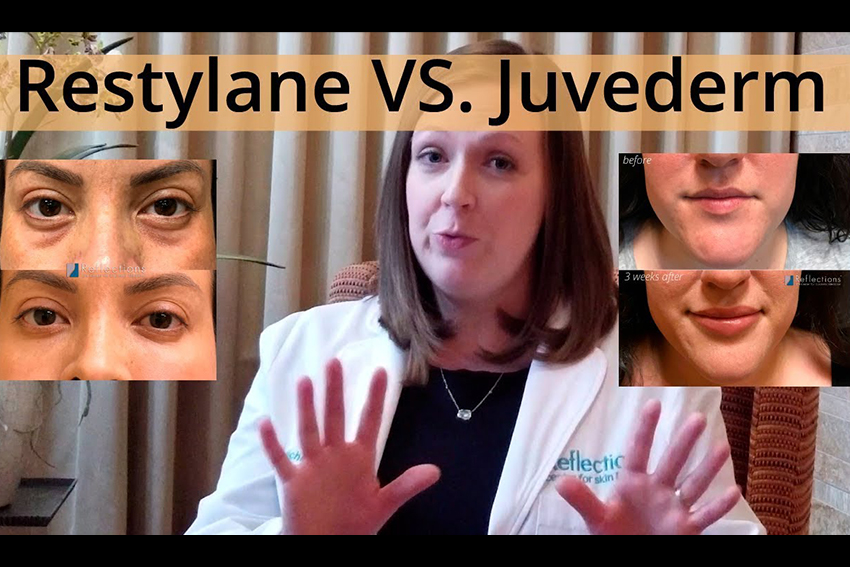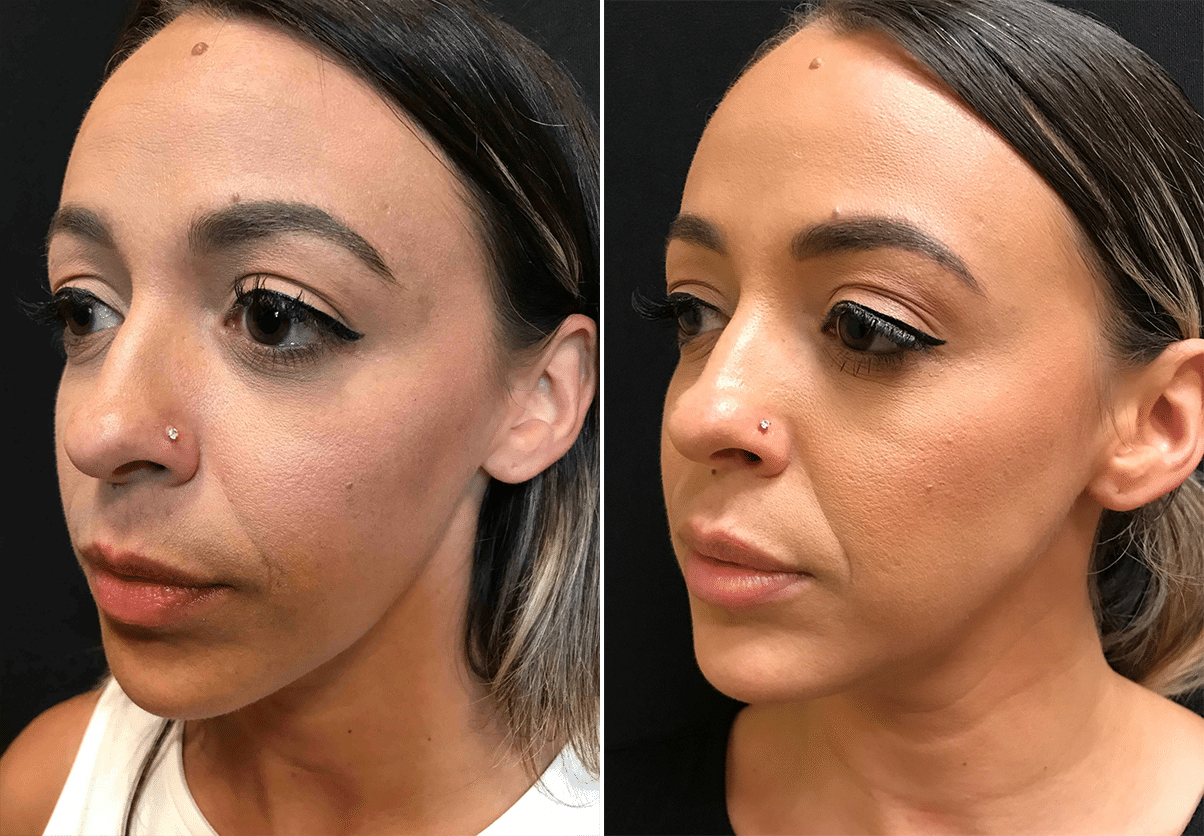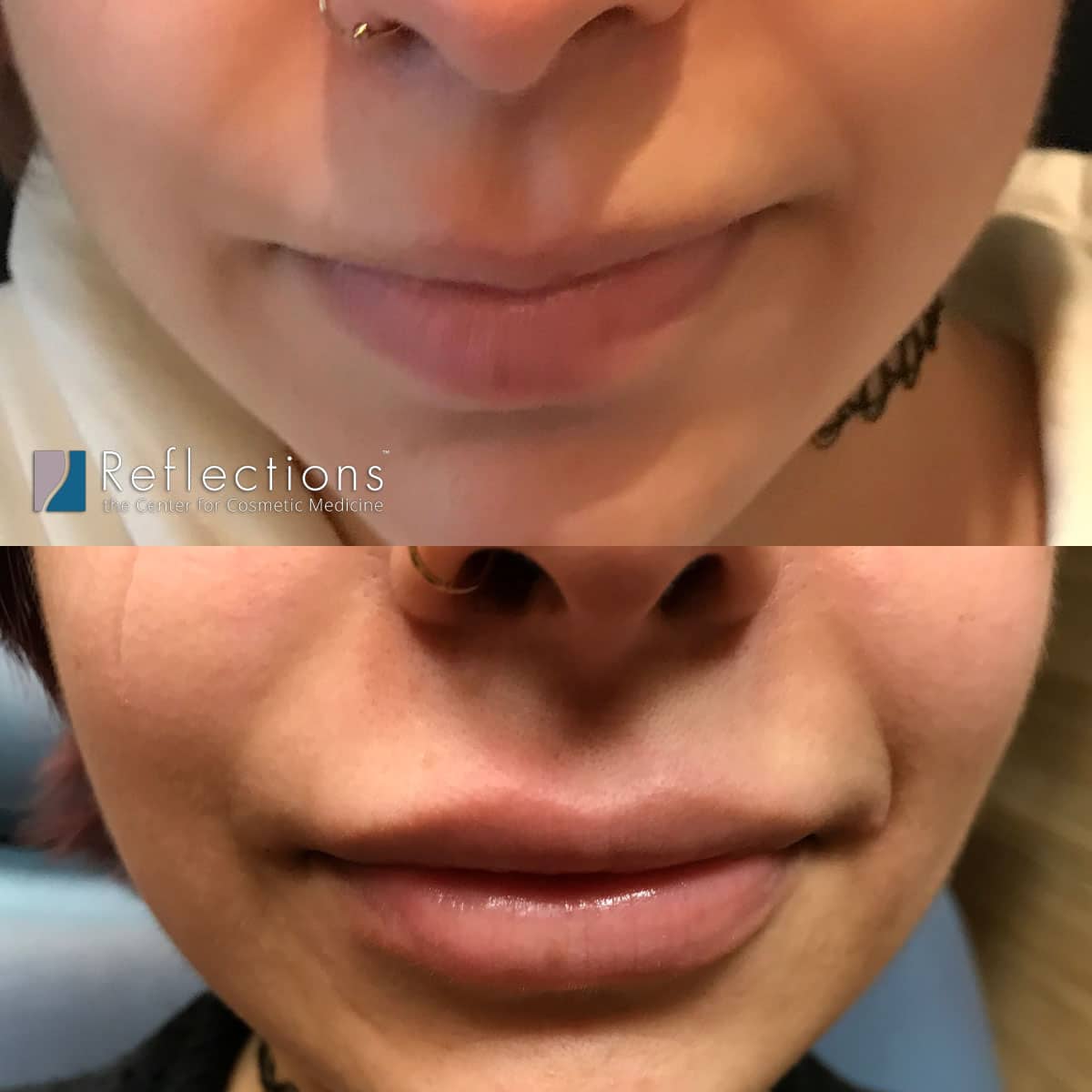Juvederm® is one of the most popular fillers used in America, and has been FDA-Approved for use in cosmetic treatments since 2006. It takes 15 to 20 minutes to perform Juvederm injections. The results are immediate and actually improve over the following week. This is because Juvederm is a hydrophilic filler, meaning that it absorbs and holds on to water easily, creating a nice plumping effect.
This is perfect for areas like the lips and cheeks where we want to get a plumping effect, but you can probably guess that this doesn’t work well for other areas. For example, under the eyes, where puffiness is definitely not the desired result. That’s why Juvederm is just one of the many dermal fillers we carry. We know there’s no one filler that’s great at everything, so we use Juvederm only for where it’s the best option.
Juvederm Quick Facts
- $650 per syringe (our most affordable tier of fillers)
- Little to no downtime (depending upon where it’s injected, some swelling or bruising is possible)
- Quick and easy treatment
- Ideal for restoring lost volume under the skin for a more youthful appearance
Most Common Uses for Juvederm
Juvederm Lip Filler
Juvederm really became a household name as lip fillers became popular over the past several years. It’s the most popular filler for lip injections because it is the most hydrophilic filler on the market, and that ability to swell and hold onto water gives lips a “bee stung” appearance that so many younger patients are looking for. Best uses for Juvederm include:
- Lip enhancement
- Redefining lip border
- Wrinkle correction
- Diminishing worry lines, smile lines (nasolabial folds), crow’s feet, marionette lines at corners of the mouth (oral commissures), and smoker’s lines (vertical lip lines)
- Reducing the severity of nasolabial folds
- Chin augmentation
- Jawline Contouring and Softening the appearance of jowls
- Filling cheek depressions
- Softening acne scars
- Creating a temporary eyebrow lift
- Correcting facial depressions caused by fat loss
- Recovery & Downtime: Expect some swelling for first 24-48 hours with this filler
- Numbing: Mixed into the injections
- Cost: $650 per syringe
- Type of Result: Plump and Gummy – Perfect for lips and sometimes other areas, too
- When to See Results: Immediately, but finalized around 2 week mark
- How Long do Results Last: 6-12 months, depending upon where it’s used within the face

View All Juvéderm Ultra Before & After Results
More Before & AftersFrequently Asked Questions On Juvéderm Ultra & Ultra Plus
- What is Juvederm filler not a good choice for?
Juvederm is a really versatile filler, but because it has a tendency to attract and hold onto water, causing it to swell, it’s a bad idea for the under eyes. Under eye filler is a very popular procedure at our office, we just don’t use Juvederm for that.
We also don’t use Juvederm for patients who want smoother or more defined but not bigger lips. We have better options for that.
Finally, Juvederm doesn’t provide the firm lift that Voluma or Lyft can, and for that reason, we tend not to use it for lifting the cheeks. It can be used to softly fill the cheeks, and to add volume, but it simply can’t lift in the way some other fillers or threads can.
- How much does Juvederm cost?
Price is probably one of the most common questions we get when it comes to dermal fillers. Juvederm is our most affordable filler, at $650 per syringe.
- How many syringes of Juvederm do I need?
For the vast majority of our patients, the answer is 1 syringe of Juvederm is all you need. A single syringe of Juvederm, carefully placed by skilled injectors, can make a big impact.
First, Juvederm swells, as we’ve mentioned before. That effect typically occurs in the first week or two, and after that the filler “settles” into its final result. So we often recommend a single syringe per treated area per visit, with at least 2 weeks before more filler is added, for that very reason. Not all fillers work this way, but you don’t want to fill to perfection with Juvederm only to have to swell and look weird later.
Now, the number of syringes you’ll need to achieve your goal results is individual to you, and we can’t give you a precise estimate until we see you in person for an evaluation. However, we can give you rough ideas based on what we typically use for a given treatment area.
Most patients wanting Juvederm lip filler will need a single syringe to create the results they’re after. Occasionally, lip filer patients will need 2 or 3 syringes, though. In that case, we always suggest 1 syringe per appointment, to ensure we’re not overdoing it (and also to reduce your chances of bruising).
Nasolabial folds (smile lines) generally take 1 syringe of Juvederm. When they’re more severe, we often lift the cheek from above using Voluma or Lyft.
Jawline contouring often takes 2 syringes of Juvederm or 1 of Juvederm plus a syringe or two of other fillers. This is because the jawline often needs a significant amount of filler to replace lost volume.
Cheeks almost always take 2+ syringes of filler, though we often use 1 syringe of Juvederm along with other fillers when restoring or lifting the cheeks.
Acne Scarring usually only takes 1 syringe of Juvederm because you’re filling in such small spaces behind scars. Most patients who have this treatment will have “leftover” filler which we can use in other areas (since excess filler cannot be saved for future use).
Frown creases generally require 1 or less than 1 syringe of Juvederm filler, and many of these patients find they’re able to treat other areas with the excess.
- Will I need more than 1 syringe of Juvederm?
Whether treating the lips, nasolabial folds, cheeks, or elsewhere, many patients will be happy with the results from just a single syringe of Juvederm. However, there are patients who will need more than 1 syringe of Juvederm to get the results their after. Lips are a great example of where this might happen, especially for those who are trying to dramatically reshape or increase the size of their lips.
In the case of using multiple syringes of Juvederm for lip augmentation, we typically recommend that patients “stage” their treatment – in other words, you will need to have injections done more than once to achieve a natural result when using more Juvederm in the lips.
Above, we discuss in more detail how many syringes we typically use in a given area, but you will be given a personalized estimate and price quote during your free consultation with one of our physician injectors.
- How is Juvederm different from Botox Cosmetic?
Juvederm is used to treat wrinkles and folds resulting from a loss of volume beneath the surface of the skin, such as in the nasolabial folds. BOTOX® Cosmetic relaxes muscle activity and is used to treat moderate-to-severe lines caused by repetitive muscle activity. Common areas where BOTOX is used include the area between the eyebrows (the glabellar area), the crow’s feet region, and in the forehead. It is very common for Juvederm and BOTOX to be used in combination for long-lasting, exciting results.
- Is treatment with Juvederm injectable gel painful, and is downtime required after treatment?
Juvederm injections are tolerated quite well. Some patients desire pre-treatment with topical anesthetic. For lip enhancement we recommend local anesthetic injections similar to what a dentist provides. There is no discomfort after the procedure. If there is mild swelling or bruising, this is generally short lived.
The image below shows a patient before, immediately after injection, with some swelling, and then 3 weeks later, when the swelling would have long-since resolved.
- What are the possible side effects of Juvederm?
Most side effects are mild in nature, and their duration is short lasting (five days or less). The most common side effects include, but are not limited to, temporary injection site reactions such as: redness, pain/tenderness, firmness, swelling, lumps/bumps, bruising, itching, and discoloration. As with all skin injection procedures, there is a risk of infection. Complications are very rare with Juvederm 1

- What are the pretreatment recommendations?
One week before injections, we suggest avoiding St. John’s Wort, high doses of vitamin E, aspirin (unless prescribed by physician), Advil, Nuprin, and other agents that can increase bruising. If you are prone to cold sores, we may want to institute antiviral therapy, such as Famvir or Valtrex. There is no pre-treatment allergy skin test required before the use of Juvederm .
- Can Juvederm be reversed?
Yes, Juvederm can be dissolved using hyaluronidase or hylenex. Our practice, unfortunately, sees many patients each week that need filler injected by other providers dissolved and revised. With Juvederm, the most common complaint is lumps and bumps, especially in the lips. We do recommend you wait at least 2 weeks after your initial injection to make any decision about dissolving, since swelling can mimic bumpy filler for at least the first few weeks. Our physician injectors will evaluate you for revision and dissolving of filler during your free consultation. Please contact us to schedule a consultation if you are considering dissolving your Juvederm.
- Can you get half a syringe of Juvederm?
We do not usually inject less than 1 syringe of Juvederm.
- Can I wear makeup after Juvederm?
Yes, but only after 1 hour has passed since injection, and youll need to be more careful than usual about cleanliness as you apply your makeup. Thoroughly wash your hands and brush/makeup applicator prior to applying makeup, and avoid covering the injection insertion points for 24 hours.
- Can Juvederm cause blindness?
Any filler in the wrong hands may cause complications including damage to the skin and/or blindness. That is why it is so important to use an experienced and skilled injector.
- Can Juvederm migrate?
Yes, but it should not if it is injected properly and you take the proper post-injection precautions. Proper injection technique deposits filler into the right planes of the tissues and in the right droplet sizes, making it less likely to migrate. As for post-care, youll want to avoid pressing and manipulating the treatment area for 36 hours, to allow filler to naturally settle into its new home. This doesnt mean you cant touch the area, but you wouldnt want to lay on your face to have a massage, for instance, or wear a tightly-fitting motorcycle helmet – for those 36 hours directly after injection.
- Does Juvederm dissolve over time?
Yes, Juvederm dissolves over time, as do all hyaluronic acid fillers. Generally, we say it lasts about 6-12 months. The rate of breakdown (or duration of result) is greatly affected in Juvederm specifically by the amount of movement in the area where it is placed. For instance, mouths move quite a lot, and Juvederm breaks down much faster here than it will in the nose, where the tissues move far less. The dissolving nature of Juvederm is what allows us to dissolve it with an enzyme if there is a complication or undesired result, and many patients very much like having this option available to them.
- Does Juvederm expand?
Juvederm is hydrophilic, meaning it loves water. It will draw water molecules to itself, and hold them in place in the skin. In this way, Juvederm sometimes appears to swell slightly, especially directly after it is placed. There is, obviously, a limit to the number of water molecules Juvederms molecules can hold on to, so the effect is fairly mild and limited in nature. This is different than some other hyaluronic acid fillers, such as Restylane, which does not attract water. We cover this in more detail in our blog Restylane vs. Juvederm.
- Does Juvederm look natural?
The natural-ness of your Juvederm result is completely dependant upon the skill and expertise of your injector. Think of Juvederm like paint and the injector like the painter. The result can be a masterpiece, or a mess – it totally depends upon the injector.
- Does Juvederm soften up?
No, Juvederm itself stays the same. However, what you tend to feel immediately upon injection is firmness due to swelling and inflammation (think of how a newly-bruised area will feel like a firm bump). While we will do our best not to bruise you, you should expect swelling and firmness that will resolve within a few days, and will likely not be visible to others, but you will be able to feel it when you touch the area. As that swelling is dissipating, Juvederm will also be attracting water to itself, and these 2 effects happening simultaneously may feel as if Juvederm is softening.
- How long after Juvederm will I see results?
You will see an immediate change from Juvederm, but your final results should be settled in by the 2-week mark, if not before. In the first few days, you will see and feel some swelling, and that usually is worst on the day after injection, and then usually mostly gone by day 3-5.
- How long does Juvederm last?
How long your Juvederm will last depends upon 3 factors: Injection technique Location being injected (lips vs. cheeks vs. jawline) Your metabolism Juvederm being placed in the right depth and plane within the tissue, and in the right size of droplets will affect how long the product lasts – and really how well it stands up to movement and metabolic processes. The location being injected determines the amount of movement that the product will have to endure. Juvederm is less durable under intense movement than some of the newer gel fillers, such as Refyne or Vollure. Finally, certain individuals will notice they metabolize, or break down, hyaluronic acid fillers (which are long-chain sugar molecules) much faster than others. Many times, runners will complain they just seem to metabolize filler like no one else. Theres no studies yet to show why this may be – whether its the effect from intense cardio or whether those who enjoy running more commonly have a naturally higher metabolism – and it doesnt seem to happen for all runners. So its just anecdotal for now. But you should be aware there does seem to be a subset of people for whom Juvederm and other fillers dont seem to last nearly as long. This subset is a true minority, but it is real.
- How many syringes do I need for Juvederm for marionette lines?
Generally, 1-2 syringes of filler are needed for marionette lines. We often inject more than 1 type of filler for a given area, so that may be just 1 syringe of Juvederm, and 1 syringe of another filler, etc. We cover this in more detail on our blog.
- Is Juvederm covered by insurance?
Juvederm is not covered by insurance. Health insurance does not cover cosmetic treatments unless they are caused by a disease (not by natural aging). You should call your insurance carrier if you have questions about their coverage, as it does vary by plan. Our office does not accept health insurance for payment, but you may be able to submit treatments to them for reimbursement.
- Can you drink alcohol after Juvederm?
Although you can drink alcohol after Juvederm, it is best to wait 6 hours especially after having your lips injected. Both alcohol and salt consumption increase water retention/swelling and or bruising.
- Can you split a syringe of Juvederm?
You can certainly use a single syringe of Juvederm across multiple locations in one treatment for one patient – for example, splitting the syringe between the lips and smile lines. However, it is not advisable you split a syringe between patients or between sittings, as this increases the risk of infection and contamination. Some offices will sell half syringes of Juvederm, as you can get Juvederm in a half-sized syringe from the manufacturer. We do not sell half-syringes at our practice, since each 1ml standard syringe is equivalent to 1/5 of a teaspoon in volume. 1/10 of a teaspoon is just too small to make a visible change, and we find patients are really happiest with 1-2 full syringes of Juvederm, even for small tweaks to their looks.
- Can you wash your face after Juvederm?
Yes, absolutely you can wash your face after Juvederm. You want to first wash your hands thoroughly, and then be gentle as you wash your face so as not to rub vigrously or manipulate the filler (for the first 36 hours after injection) and to not irritate or rub into the injection insertion points.
- Does Juvederm stimulate collagen?
Juvederm adds volume due to it being composed of Hyaluronic Acid. Studies have shown that Juvederm injections do increase/stimulate some collagen production.
- Does Juvederm work immediately?
You will see immediate volumization with Juvederm which varies according to the area injected. For example, lips look plumper, nasal labial folds are softened and temple deficits are improved all giving you a more youthful look and feeling!
- How do you get rid of Juvederm bumps?
When Juvederm is injected by a qualified and experienced injector the potential for filler lumps is dramatically reduced. Most lumps are broken down by your body’s own mechanism and resolve on their own. If they do not smooth out in 2 weeks, your injector can dissolve them.
- How can I make Juvederm last longer?
One of the best ways to help your Juvederm last longer, and to save you money in the long term, is to have your next treatment before this treatment fully wears off. We cover this in more detail in our blog How to Make Your Filler & Botox Last Longer.
- How often can Juvederm be injected?
There is no reason medical Juvederm cannot be injected 1 syringe immediately after another. However, like all injections, swelling is expected and naturally occurs with Juvederm injections. Generally, after weve placed 1-2 syringes (depending upon the individual), swelling will start to distort the area a little bit. At which point, we will stop injection and allow that swelling to subside over the course of 2 weeks. This is how we ensure our results are precise and natural-appearing. For this reason, patients wishing to achieve a bigger transformation for any single area may need to have their treatments staged over a couple of treatments. However, this is the exception, not the rule. Most patients are very happy with the results from 1-2 syringes in a single area.
- How painful are Juvederm injections?
Juvederm is not very painful in the way we perform the injections. Patients should expect to feel a small pinch as we make the insertion points, but because the product is mixed with numbing lidocaine and most commonly injected with a blunt-tip cannula, the rest of the procedure feels like pressure, not pain. This procedure can be completely numbed for, as your dentist does before filling a cavity, for those who are particularly sensitive.
- Is it normal to have bumps after Juvederm?
Bumps and lumps are not expected with Juvederm. Contact your injector and let them know if you are experiencing lumps or bumps.
- Is Juvederm better than Botox?
While both Juvederm and Botox can help you look and feel refreshed and more youthful they treat different signs of aging. For example, Juvederm is used to in deep creases like the nasal labial folds to restore your natural contour, in your lips to restore youthful volume. Botox is used to slow down lines created by overactive muscles such as crow’s feet and frown lines. They both treat premature signs of aging.
- What age should you start Juvederm?
Patients age 18 or older are suitable candidates for Juvederm. You should start Juvederm at any age over 18 when you desire to make a change to your appearance.
- What is Juvederm?
Juvederm is a hyaluronic acid (HA) filler that plumps and fills the skin. It should only be injected by doctors, physician assistants (P.A.), or ARNPs in a medically safe environment, by New Jerseys legal standards. In the hands of a skilled and experience injector, it is very safe and can create very natural results to either tweak your appearance, or restore the changes made by aging.
- When did Juvederm come out?
Juvederm came out in 2006 – or received approval by the FDA, based on a clinical trial that determined its safety and efficacy.
- Which lasts longer, Juvederm or Restylane for lips?
Juvederm and Restylane both tend to last around the same amount of time when injected in a similar style, in the same location, and in the same patient.
- Is Juvederm safe to use?
Juvederm injections are tolerated quite well. Some patients desire pre-treatment with topical anesthetic. For lip enhancement we recommend local anesthetic injections similar to what a dentist provides. There is no discomfort after the procedure. If there is mild swelling or bruising, this is generally short lived.

Blog
Juvederm vs. Restylane: Which Filler is Right for You?
Juvederm vs. Restylane: How to Choose Whether you’re new to injectable dermal...
Read More
Blog
Award Winning Physicians of Reflections Center — Offering Hand Filler Injections To Restore Aging Hands
Dermal fillers are well-known for their ability to treat facial wrinkles and...
Read More
Blog
They Say Youth Is Wasted On The Young. Juvederm Dermal Fillers Can Help Change That.
The natural aging process causes our bodies to produce fewer fibers and...
Read MoreSources:
- Juvederm FDA Clearance http://www.accessdata.fda.gov/cdrh_docs/pdf5/p050047a.pdf
- Annelyse C Ballin, Alex Cazzaniga, and Fredric S Brandt; http://www.ncbi.nlm.nih.gov/pmc/articles/PMC3739705/”>Long-term efficacy, safety and durability of Juvéderm® XC; Clin Cosmet Investig Dermatol. 2013; 6: 183–189.Published online 2013 Aug 5. doi: 10.2147/CCID.S33568 http://www.ncbi.nlm.nih.gov/pmc/articles/PMC3739705/
- Grimes, P. E., Thomas, J. A. and Murphy, D. K. (2009), Safety and effectiveness of hyaluronic acid fillers in skin of color. Journal of Cosmetic Dermatology, 8: 162–168. doi: 10.1111/j.1473-2165.2009.00457.

Dr. Mitchell Chasin is a Cosmetic & Laser Physician at Reflections Center. Dr. Chasin believes strongly that the best cosmetic physicians are those who are dedicated to mastering their craft through continuing education and collaboration with the industry’s top doctors.
















